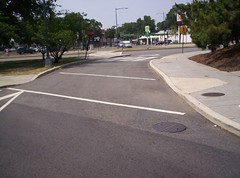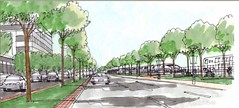(un)intelligent transportation systems (#2)

I didn't read the paper til I got on the train today, so I didn't see the article in the Post on traffic backups at Bladensburg Rd. and New York Avenue because more time was added to the walk cycle to enable pedestrians to get across the street. See "Retimed traffic lights snag New York Ave. commute : Rush-hour woes grow after D.C. officials give pedestrians more time."
As a bicycling and pedestrian planner at the moment, I suppose I could categorically advocate in favor of pedestrians and bicyclists in every situation. But very few people walk or bicycle on Bladensburg Road at that location.
-- map view
Sure you could say it's because the conditions for walking or biking are so bleak. And they are.
If you are a fan of the joke:
Q: why did the chicken cross the road?
A: to get to the other side
then you have to recognize that walkers especially don't cross Bladensburg Road there all that much because they have no reason to do so. It's an area of the city that is automobile reliant. New York Avenue functions like a freeway. Most of the uses on the street are either industrial or oriented to people in cars (gas stations, fast food restaurants, cheap hotels).
Even if you make the walk cycle longer (there is enough time for bicyclists to cross the road in the current cycle), no one will use it. Or at least few people will use it. So does it make sense to impede everybody, at all times, to provide more time to pedestrians a few times a day? (This is comparable to keeping right turn slip lanes in place, when they are used by 2 cars/hour, as was the case at Benning Road and Maryland Avenue. DDOT recommended eliminating the lane. A vocal resident said no. Rarely, in a public meeting, a DDOT official told the resident that they were making the change, that the usage of the lane did not justify its continued existence--this was in something like 2004 or 2003.)

The now deceased slip lane from Benning Road to Maryland Avenue.
So even though some commenters on the WTOP website beat me to it, it's logical that if you are going to make the change, put in a walk cycle signal that is only activated when pedestrians are there, and able to push the button.
Note that if the Abdo Development goes through, and sometime in the future New York Avenue is converted into more of a boulevard than a traffic sewer, more pedestrian-friendly and bicycling-friendly placemaking improvements make sense.
- New York Avenue Corridor Study Final Report (2006)

New York Avenue as a boulevard. Image from the 2006 study.
Labels: bicycling, provision of public services, traffic, transportation planning, urban design/placemaking, walking



0 Comments:
Post a Comment
<< Home